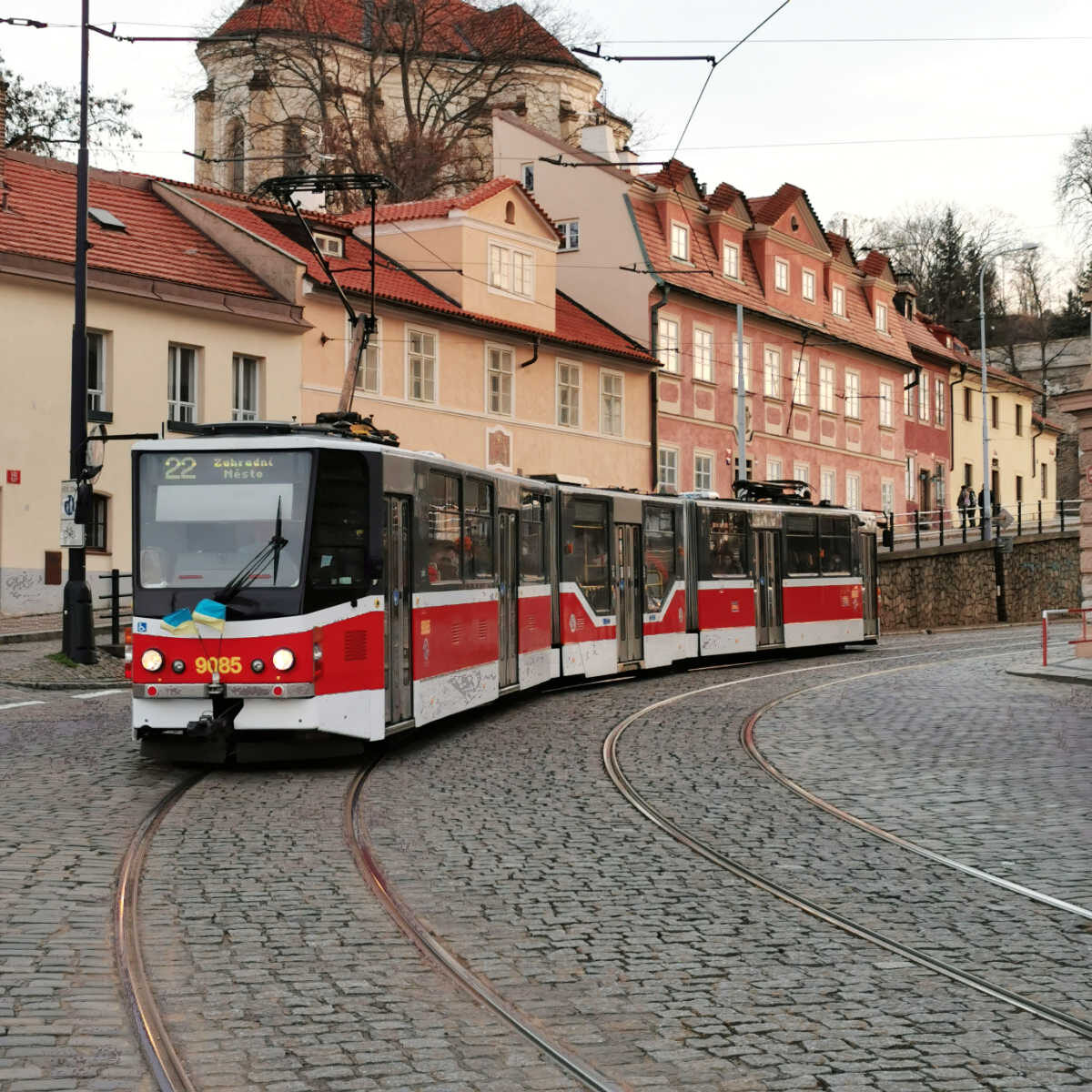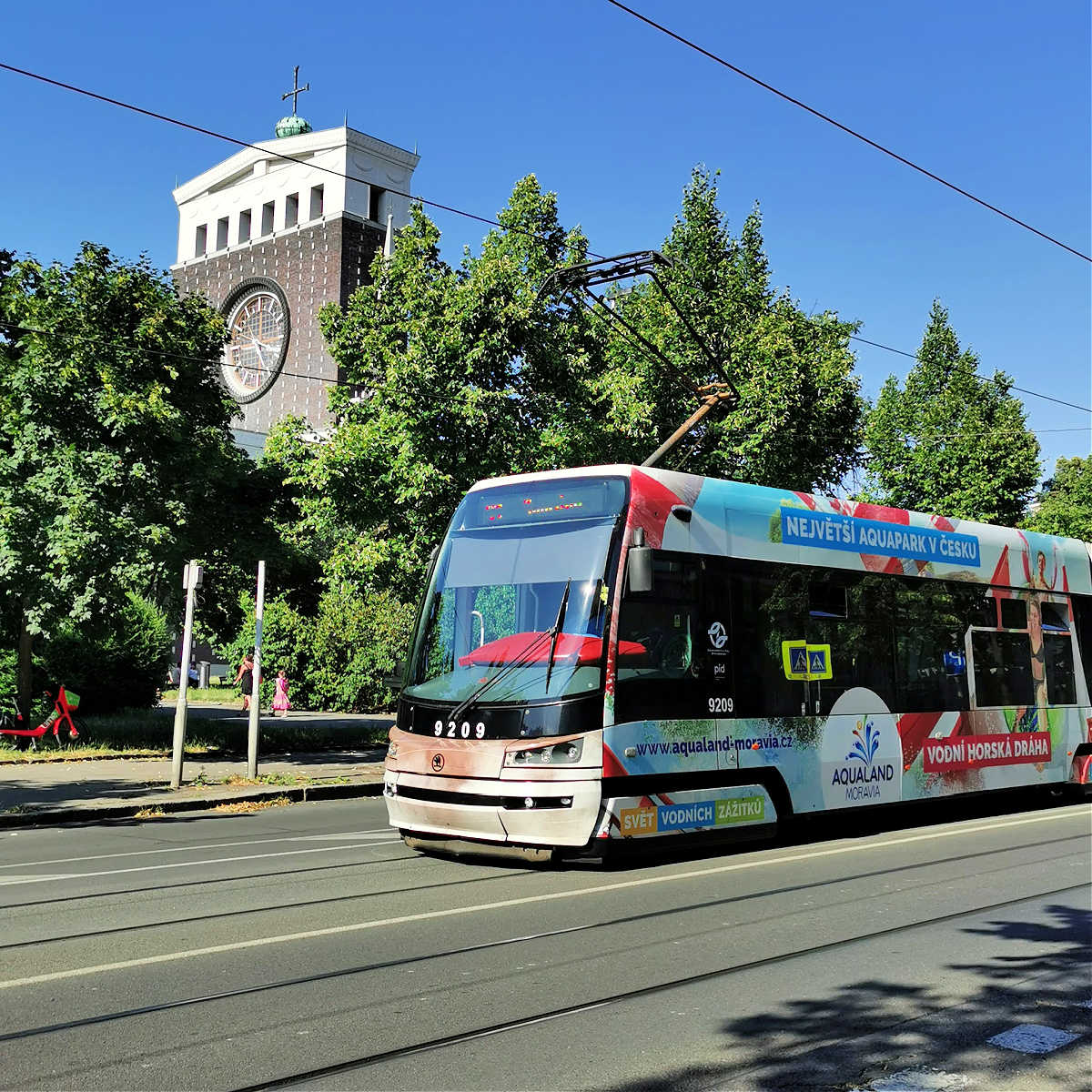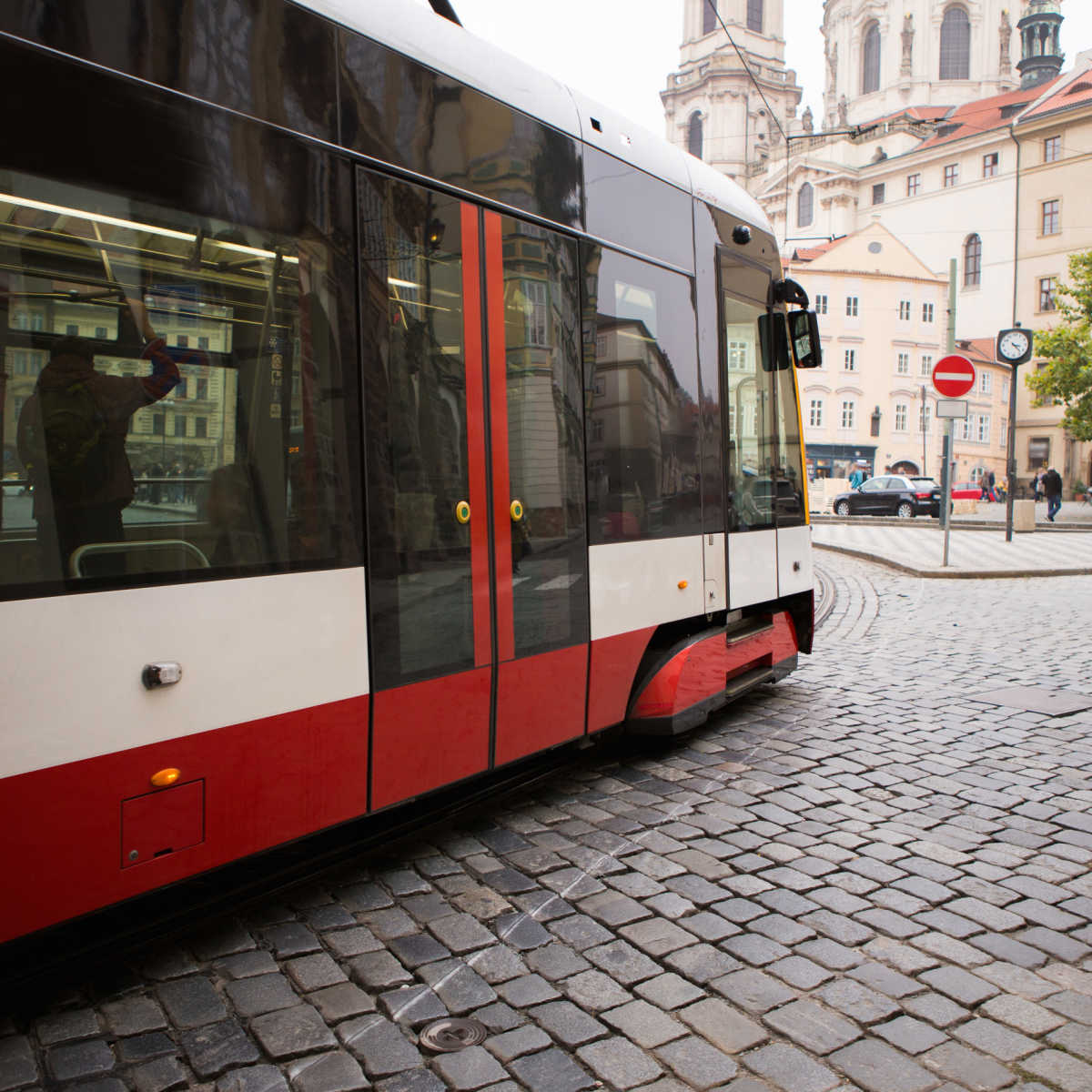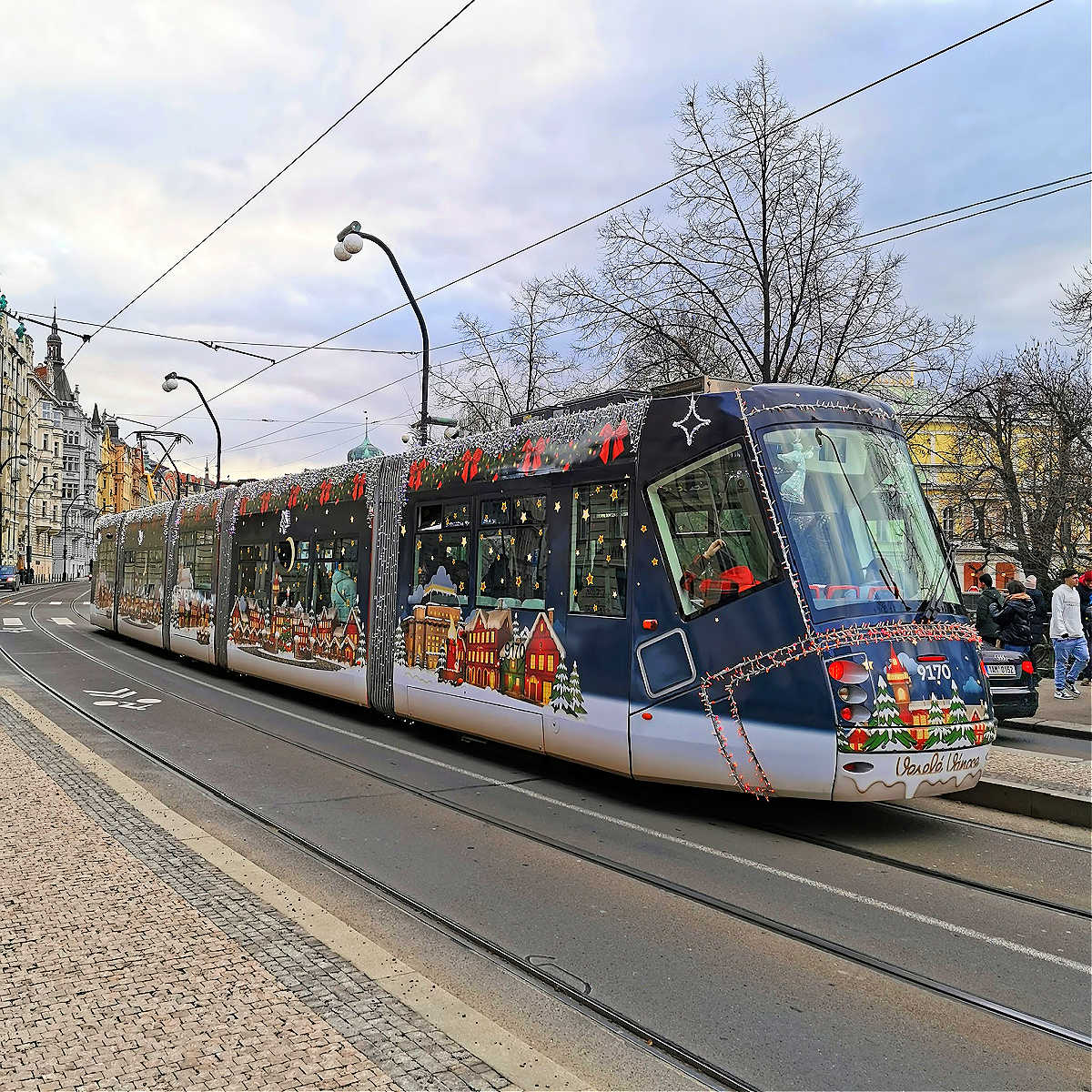The Prague tram network has over 140 kilometres of track and 26 daytime tram routes and it is the largest tram network in the Czech Republic. It’s very easy to use and you can explore Prague centre and also get quickly into the suburbs.
Travelling by tram is one of the easiest ways of getting around Prague and exploring this amazing city at the same time. It’s my favourite way to travel around Prague as you get to see a lot more than if you travel by the ‘Metro’ – the Prague underground.
It’s also a very affordable tram system – with one ticket you can travel anywhere for 90 minutes!
UPDATE FOR SUMMER 2024
A new tram line is being built at Wenceslas Square and because of that, no trams are running through the square. What this means is that most trams that ment to run through Wenceslas Square (like the number 9) finish at Narodni Trida and loop back. From the other side the trams are diverted via Senovazne Namesti and Masarykovo Nadrazi. The estimated time of completion is 1st October 2024. Other tram lines might be altered as a result of that too.

How does the tram system work in Prague
The distances between tram stops are usually very short – you can sometimes see the next stop ahead, so even if you forget your stop, you can easily walk back or hop on the next tram going back.
Prague tram system is one of the biggest in the world, in 2020 it carried over 240 million of passengers, which was the second in the whole world (after Budapest in Hungary).
There are several different tram routes and the numbers start from 1-26 for day time trams.
Prague trams are not free, but they are a great value for money.
One standard ticket is only 40 CZK and last 90 minutes, which is enough to get you from one side of Prague to another or take the tram all the way from the centre to the Prague Castle.

Do the Prague trams run at night ?
Night trams no. 91-99 run between midnight to about 4-5 am when the day time trams re-start again.
The nighttime trams use the same tracks as the day time trams but join up several routes together, so that their routes are much longer.
All trams interconnect in the middle of Prague (Karlovo Square or Lazarska Street) where you can change to get the tram you need.
The trams also wait for each other there, so don’t be surprised if your tram will stand there for few minutes.
A nice little quirk of the night trams is that the Prague transport department uses the old trams with high steps to get to the tram carriage.
There is also only one carriage, so sometimes it might feel like a bit of a squeeze with everyone trying to get home. Most of the old tram carriages also have the old types of seats which are individually heated from underneath – perfect in the cold Prague weather in winter time!

how many tram routes are there in prague ?
There are currently 26 day time tram routes, 9 night tram routes and 1 historic – tourist tram route operated by Prague tram transport. This equals 275 tram stops spaced out on 143 km of tram tracks across Prague.
As I mentioned before trams are the perfect way to explore Prague and because of that I’ve put together a few comprehensive guides that help you to do sight-seeing from the comfort of a tram seat!
READ MORE
- 9 Best tram lines to explore Prague + what to see on each route >>
- Tram Line No. 22 sight-seeing guide >>
- How to explore Prague with the historic tram no. 42 >>
- Hidden gems on the tram line no. 9 >>

types of Tram Tickets in Prague (Full Price)
Short time ticket – 30 CZK
This ticket is valid for 30 minutes only. This type of ticket is perfect for shorter journeys.
Longer time ticket – 40 CZK
This standard ticket is valid for 90 minutes and you can make as many changes as you like and travel on any tram or other public transport.
1 Day ticket – 120 CZK
This ticket is valid for 24 hrs from the time you validate your ticket (including the next day or whenever your 24 hrs runs out).
There is no restriction on this tram ticket. It is valid any time (peak, off-peak, night time) and on any type of Prague public transport, which makes it a such great value.
3 day ticket – 330 CZK
The three-day ticket works in exactly the same way as the one-day ticket, but it’s valid for 72 hrs in total.
READ MORE

How to buy a tram ticket
Paper tram tickets can be bought in yellow vending machines at some major tram stations (or at any underground (metro) station). Most of these vending machines take Czech crowns (Czech currency only), and you can also pay with any debit or credit card.
You can also buy tram tickets on the trams, but you need to use your payment card for this. The ticket machines inside the trams are easy to use, you just select the type of ticket you need – 30 or 90 minutes or 24 or 72 hrs ticket and tap your card.
The ticket machines (see my picture above) are usually in the middle of the tram, so if you are buying your ticket on the tram, that’s the best place to get on.
You can also download an PID Litacka app to your phone and buy your ticket via the app. You need to buy your ticket at least 2 minutes before you board the tram (or any other Prague public transport) and make sure that the ticket is activated within the app otherwise, it won’t be valid.
The app is translated into English, so you shouldn’t have any problems following the instructions.

Make sure you always validate your tram ticket
Once you buy your ticket, make sure you validate it in the smaller yellow ticket machine on the tram. The machine stamps it with a date and time, and you have either 30 or 90 minutes (or 24 or 72 hrs) to get to your destination, including any changes. The ticket is also valid on the underground or Prague bus or train.
You don’t need to validate ticket that you’ve bought on the tram (in the larger orange machine), because those tickets already come with stamped time.
You also don’t need to validate the ticket again when you change from one tram to another (or bus, underground etc within the time of your ticket validity), just keep your ticket with you.
Ticket Inspectors & Fines
A word of warning – ticket inspectors are in plain clothes (not uniforms) and do regular spot checks, especially on the well known tourist trams, such as the tram 22. They usually work in 2 or 3 and can get on the tram at any point.
Currently, the fine is 1500 CZK, but if you pay on the spot or within 2 weeks, you’ll only pay 800 KCZ.

Trams have a right of way on the pedestrian crossing
Whether it’s right or wrong, the fact is that in Prague, trams have the right of way at a pedestrian crossing and anywhere on the road.
Do not cross in front of the tram or try to run across the street in front of the tram as you never know how fast the tram is travelling and the tram won’t slow down for you. The trams are very heavy and stopping is not easy for them.
If the tram has to make an emergency stop or try to slow down, the trajectory is still quite long, and it might still hit you if you are not quick enough to move away from the tracks.

How to travel on Prague trams
There are a few quirks that might be worth mentioning when travelling on Prague trams.
Don’t talk to the tram driver unless it’s an emergency, in which case use the emergency button, which can be found in several spots within the tram carriage.
Trams automatically stop at most of their stops. There are few stops (usually on the outskirts of Prague) where you need to press the stop button to get the tram to stop otherwise the tram will carry on and won’t stop.
In the winter and the heat of the summer, some tram doors don’t automatically open unless you press the circular touch points on the door (new trams) or press the door button (old trams).
I’m assuming that this is because in the winter the trams are trying to keep the heat in and in the summer, the trams that have an air-conditioning need to keep doors closed to prevent the hot air coming in.
It’s good manners to give up your seat to older people, people who struggle with mobility or find it difficult to stand without asking. Even better, don’t sit on the seat marked with a disabled label next to the doors.

How to tell which tram has air-conditioning
Only modern trams with easy access have air-conditioning. They usually have different advertising or colours on them and the driver looks like he/she is sitting behind a giant red M&M (that’s lentilka to me….), well at least that’s how it always looks to me!
The trams look like the one on my picture above – this one has lovely Christmas decorations on and only runs during December in Prague.
If you visit Prague in the summer and it’s a heatwave, it’s the only way to travel without fainting!
The old fashioned trams (usually just the red ones without any advertisements) don’t have any air-conditioning. If you sit at the back you will also have heated seats, which is definitely something you don’t want in the summer.
This blog post was originally written on 3 January 2023 and last updated on 22 July 2024
PIN TO KEEP FOR LATER

